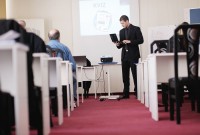- Home
- Business Processes
- Industry Knowledge
- Aerospace Industry
- Automotive Industry
- Banking Domain
- BFSI Industry
- Consumer/ FMCG Industry
- Chemicals Industry
- Engineering & Construction
- Energy Industry
- Education Domain
- Finance Domain
- Hospitality Domain
- Healthcare Industry
- Insurance Domain
- Retail Industry
- Travel and Tourism Domain
- Telecom Industry
- Leadership Skills
- eLearning
- Home
- Leadership Skills
- Leadership Theories
- Fiedler Model of Leadership
Fiedler Model of Leadership
The Fiedler Model of leadership is a contingency theory and states that a leader's effectiveness is based on the situation. There is no one best style of leadership and the effectiveness of a leader in an organization depends on matching the leader to the situation. Leaders should determine the natural leadership style and assess the situation to flex the style.
Related Links
You May Also Like
-
Lewin’s Change Management Model
Lewin's change management model is a framework for managing organizational change. Lewin's methodology of different Leadership Styles recognizes three distinct stages of change - creating the perception; moving toward the new desired level of behavior and, ensuring new behavior as the norm.
-
The two-factor theory also known as Herzberg's motivation-hygiene theory and dual-factor theory. This motivator-hygiene theory states that certain factors cause job satisfaction whereas certain separate factors cause dissatisfaction in the workplace. An organization can adjust these factors to influence motivation. These factors are respectively termed as motivators and hygiene factors.
-
Role theory is a concept in sociology and the role theory of leadership borrows these concepts to explain how people adapt to specific organizational and leadership roles. How the leaders and followers in an organizational context define their own roles, define the roles of others, how people act in their roles and how people expect people to act in their roles within the organization.
-
Strategic Contingencies Theory is a theory of intra-organizational power. The power of a subunit or individual depends on a few contingencies and that the more contingencies are controlled by a subunit, the greater is its power. The theory focuses on tasks that need to be done in the form of problems to be solved, thus de-emphasizing personality.
-
The great man theory of leadership is a 19th-century idea that states a person is either a natural-born leader or not. Some people are born with the necessary leadership attributes that help them create a great impact on society, politics, or the military. The theory focuses on identifying the innate qualities and characteristics possessed by great men.
-
Socio-technical theory of leadership focus on the presence of two subsystems in every organization, the interrelatedness of social and technical aspects of an organization. Theory pertains to the social aspects of people and technical aspects of an organization, which means structure and processes within the organization.
-
Trait theories of leadership explain the leadership traits that have been studied to determine what makes certain people great leaders. The practical application of the theory is looking at how the leader‟s behavior affects their subjects.
-
The Vroom-Yetton model is designed to optimize for the current situation the leadership style for best decision-making. Its a decision model formulated with contribution from Arthur Jago on how to make group decisions. The leader must gather information from the team prior to making the decision and involves more people in the decision process.
-
Social learning theory is a theory of learning process that states that most human behavior is learned observationally through modeling. Behavior change can occur in response to leader modeling and learning occurs through the observation of rewards and punishments. The focus of this approach has been teaching leadership across formal and informal settings.
-
Process & Stages of Creativity
Creative ideas do not come just like that. There is a process to it. There are a number of techniques of creativity to support the generation of ideas but the widely practiced ones are brainstorming and lateral thinking. Most innovations are not so much the product of sudden insights as they are the result of a conscious process that often goes through multiple stages. The creative process can be divided into four stages of preparation, incubation, evaluation, and implementation.
Explore Our Free Training Articles or
Sign Up to Start With Our eLearning Courses

About Us
Learning
© 2023 TechnoFunc, All Rights Reserved










